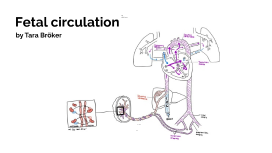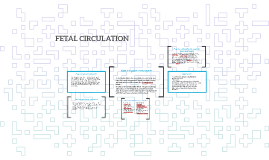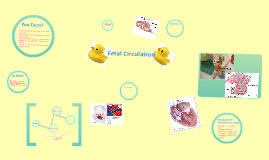Fetal Circulation
Transcript: Fetal Vs Newborn Circulation By Maria 11/07/22 Introduction Start Fetal development takes place in the uterus. In the uterus, the fetus is surrounded by the amniotic sac and fluid. These features and the underdeveloped state of the organs make it impossible for the fetus to perform respiration and digestion. As a result, both the mother and fetus develop unique structures to allow oxygen and nutrients to make its way into and throughout the fetus's body. Fetal Anatomy The fetus's circulatory system is set up in a way that makes it possible for the fetus to absorb all things necessary for growth and life through the placenta. Fetal circulation completely bypasses the lungs as the fetus can not perform respiration until after birth. The system also bypasses the liver as is also not fully functional until after birth. Fetal anatomy Unique Structures Unique Structures The circulatory system is much more intricate during the fetal stage than after birth. Most of the circulatory, pulmonary, and digestive functions are performed by the mother during this stage of development. Because of this, unique structures such as the placenta, the umbilical arteries, etc develop. They perform many important functions. For example, the placenta and umbilical cord act as a filter for nutrients and oxygen from the mother's blood. They also remove waste from the fetal circulatory system. As a result of the mother providing these necessities and performing these functions, circulatory shunts such as the ductus venosus, the foramen ovale, and the ductus arterious are necessary to the bypassing of the fetal lungs and liver. The fetal liver and lungs are completely unnecessary so, the shunts make for an efficient use of energy and resources. The Placenta Placenta The placenta is a disk-like organ that is attached to the uterine wall during pregnancy and is made of cells contributed by both mother and fetus. The main functions of the placenta are to provide the fetus with oxygen, nutrients, and waste removal through the umbilical cord. Without the placenta to perform these functions, the fetus would not get the nutrients, oxygen, and protection from disease crucial for it's survival and growth. In simple terms, the placenta is necessary because the digestive and pulmonary systems of the fetus are not fully functional and are bypassed by the circulatory system. If the placenta malfunctions, it may result in low birth weight, birth defects, premature birth, and the fetus being more prone to infection. 5-30 minutes after birth, the placenta is also delivered by the mother. If this third stage of labor is not successful, It may lead to hemorrhaging and infection. How does blood flow through the placenta? Blood from the mother fills intervillious space (space between chorionic villi) where nutients and oxygen from the mother are exchanged with deoixygenated blood and waste from the fetus by the maternal pulse. All of this is conducted through the umbilical cord. Fun facts- The placenta also produces hormones to help the fetus grow Ductus Venosus The ductus venosus is one of the three shunts in the fetal circulatory system. This shunt's main purpose is to allow for the passage of oxygenated blood from the umbilical cord through the inferior vena cava and the rest of of the body excluding the liver. This shunt is extremely important because the liver is not fully functional until after the birth of the fetus. Issues with, or a lack of, the ductus venosus can lead to many issues with the fetus such as congenital anomalies (ie. facial clefts, hemivertebrae, cardiac, genitourinary, and gastrointestinal.) After birth, blood pressure in the umbilical sinus decreases and as a result, the shunt retracts, narrows, closes and becomes the ligamentum venosum. Fun fact: Prostaglandin acts to keep the shunt open. Ductus venosus Foramen Ovavle Foramen ovavle Purpose & why: The foramen ovlae is the hole found between the left and right atria of the fetus. The opening's purpose is to to make the bypassing of the pulmonary system possible by allowing blood to pass between the atria. This is important because the lungs are not functional untill after the birth of the fetus and the "shortcut" helps avoid the heart straining itself by pumping blood to unecessary structures(ie. the lungs). Soon after birth when pulmonary circulation is made possible and blood pressure rises in the left side of the heart, tissue grows to close the opening. This results in separation between deoxygenated blood in the right atrium and oxygenated blood in the left atrium. However, if tissue fails to close the hole properly, the probability for strikes is greatly increased as clots can travel from the right to left atrium and later all over the body. Ductus arteriosus Ductus arteriosu Purpose & why: The ductus arteriosus is another of the fetal circulatory shunts. It is a found between the pulmonary artery and the aorta. It sends deoxygenated blood to the lower body of the fetus so that

















